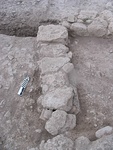| Collection: | Corinth | |
| Type: | Basket | |
| Name: | Nezi Field, context 426 | |
| Area: | Nezi Field | |
| Context Type: | Drain | |
| Title: | Stone-built drain | |
| Category: | Structure | |
| Notebook: | 1101 | |
| Context: | 426 | |
| Page: | 0 | |
| Date: | 2008/06/12 | |
| Stratum: | ceramic, brick, stone blocks of wall up to 80%. Stone blocks were boulder-sized, sub-rounded to platy when not squared | |
| Description: | Top slope of the context is slight down to the SE. The soil color is dark brownish brown. It is sandy silt. Structure materials: limestone, tile. Material size: .38 x .27 to .12 x .10. Material finish: unfinished, roughly hewn. Material construction: mixed. Material bonding: none. Features: possible southeastern most block could be spolia. | |
| Notes: | Structure 426 is a stone-built drain. It runs NW-SE. In the N, we have the drain slabs in situ, but not to their full extent. One stretch runs about a metere, is truncated, and then aonther stretch picks up about half a metere to the S an dcontiues for about .75m. No more stones of this structure are presently visible N of wall 366. S of wall 366, we have large stones that are aligned with the bearing of the drain slabes further to the N> We interpret these as covering slabs, and presum that below them are the drain slabe. These cover slabs run almost up to the large stones that bound cut 431 to the S, which stones are on top of the corbelled well/cistern head 346. It is quite possible that structure 346 is the outlet for stone-built drain 426. One obvious problem with this interpretation is that we connaot see 426 running into 346 in the section created by our excavation of pit 431, which cut and truncated structure 346. April 3, 2012 We began by removing the blocks. The matrix between the blocks was sandy silt and soft, though compressed by the weight of the blocks. Not stone blocks or tile marked the bottom of the drain, and the soil there did not appear to be different from the matrix on each side of 426, though harder packed. This compact surface was carefully scraped away prior to continuing excavation. April 27, 2012 After examining notes from previous excavation seasons, and examining what was left of the drain north of wall 366 and its chronological relationship to the surrounding stratigraphy, we are reasonably sure the drain cuts through and thus post dates all deposits the room bounded by walls 366, 332, 306 and 365. It also appears to cut the wall 366 and could go under wall 365 and therefore 426 as continuing into the room to the south, as well, which should be explored further as finding the frain to the south would finalize the idea that the circular 346/671 structure and the pit both cut the drain. | |
| Context Pottery: | Cooking ware. inwardly sloping rim stewpot (950-150)1 rim. ; Fineware. Byzantine, amphora. | |
| Pottery Summary: | 9 frag(s) 0.06 kg. (0% saved) coarseware. | |
| 6 frag(s) 0.03 kg. (0% saved) cooking ware. | ||
| Period: | Late Byzantine (1059-1210 AD) | |
| Chronology: | 12th c | |
| Grid: | 260.3-259.26E, 1004.97-1011.75N | |
| XMin: | 259.26 | |
| XMax: | 260.3 | |
| YMin: | 1004.97 | |
| YMax: | 1011.75 | |
| Site: | Corinth | |
| City: | Ancient Corinth | |
| Country: | Greece | |
| Masl: | 86.59-86.92m. | |
| References: | Report: Nezi Field 2008 by Joseph Lillywhite, Joel Rygorsky, Matthew Sears, Martin Wells (2008-04-07 to 2008-06-13) Images (4) |
|


